Introduced in 1963, the split-window Corvette is highly regarded as an iconic model in the Corvette family and the pinnacle of vintage 'Vettes. The 1963 split-window model is the fruit of visionary designers and engineers who sought to combine performance and innovative styling in a sports car.
The 1963 model marked the beginning of the second generation of the Corvette's history and was the first time a Corvette would be offered in coupe form.
The prominent engineer Zora Arkus-Duntov played a significant role in injecting true performance into the Corvette, incorporating small-block Chevy V8 engines, high-lift camshafts, fuel injection, four-wheel disc brakes, and critically acclaimed performances at Pikes Peak and Daytona.
This era marked the merging of engineering and styling expertise, with General Motors leading the way in design and engineering during the postwar auto industry boom of the 1950s.
See also: Revisiting the Timeless Elegance Of The Bristol 401 Farina Cabriolet
The Split-Window Corvette Design Language
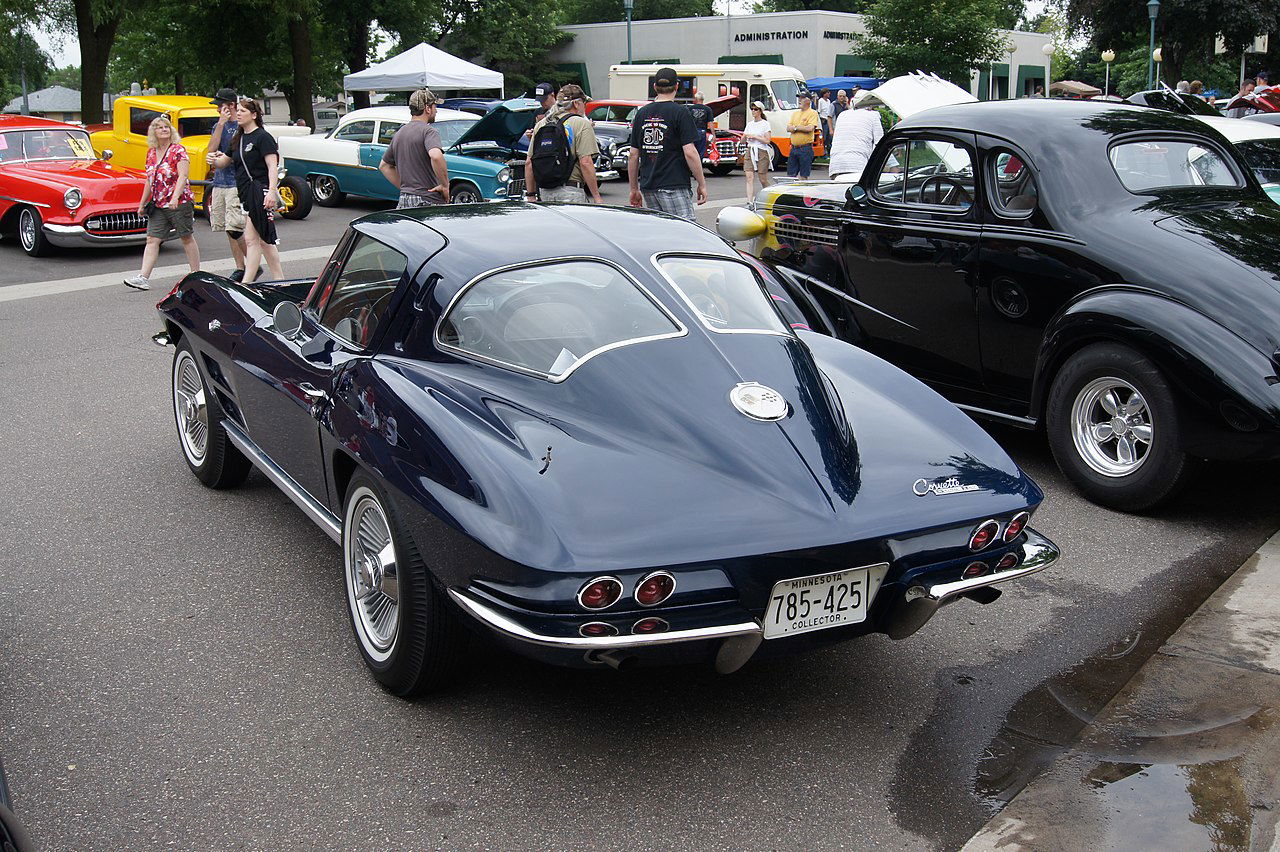
Photo credit: Greg Gjerdingen via Wikimedia
William L. "Bill" Mitchell, a prominent designer and Corvette enthusiast, contributed to the unique and innovative split-window design of the 1963 Corvette. Mitchell's fascination with marine life, particularly the stingray, mako shark, and manta ray, influenced the design of the Corvette, leading to the creation of the distinctive split window.
The C2’s debut was the first opportunity for Mitchell to deliver his vision for the Corvette to the public, and his design language for the ‘63 was directly consistent with its Stingray name.
With more than 10,000 split-window Corvettes built in 1963, only 278 were equipped with factory air conditioning, making them ultra-rare and highly sought after by classic car collectors.
The split-window Corvette represents a combination of innovative design, superior performance, limited production, and a significant milestone in Corvette history.
Origin Of The “63 Corvette Sting Ray
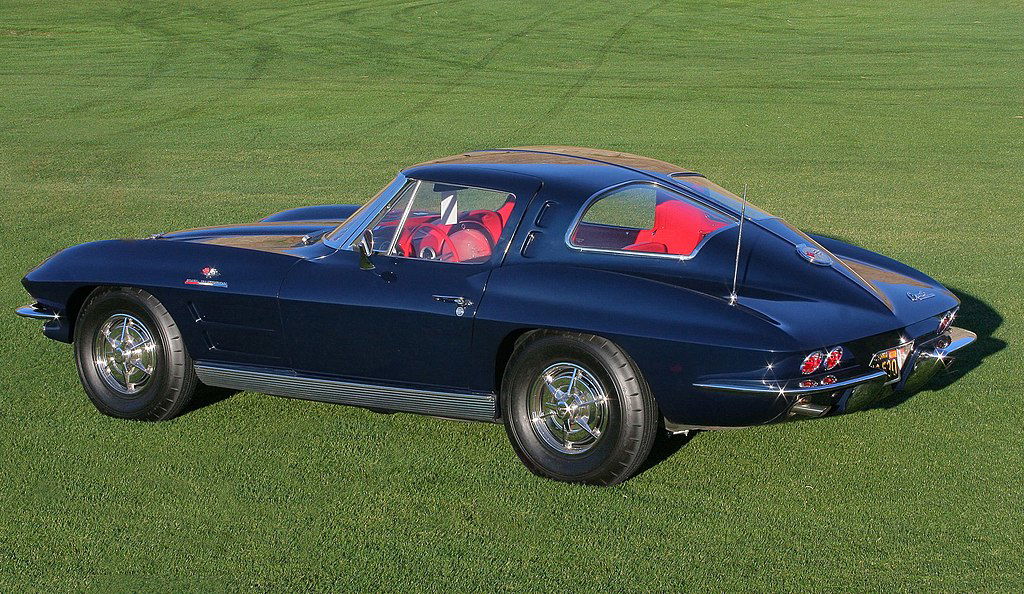
Photo credit: Rex Grey via Wikimedia
The lineage of the 1963 Sting Ray production car can be traced back to two distinct GM projects: the Q-Corvette and Bill Mitchell's racing Sting Ray.
In 1957, the Q-Corvette envisioned a more advanced, coupe-only model with features like a rear transaxle, independent rear suspension, and inboard-mounted four-wheel disc brakes.
The exterior design showcased peaked fenders, a long nose, and a short, bobbed tail. Simultaneously, Zora Arkus-Duntov and other GM engineers were captivated by mid and rear-engine designs. Duntov explored this layout with the CERV I concept in 1959.
While a rear-engined Corvette was briefly considered in 1958–60, it evolved into the experimental project XP-720, incorporating elements from the Q-Corvette and the Sting Ray Special racer.
This project ultimately led to the production of the 1963 Corvette Sting Ray, aiming for enhanced passenger accommodation, more luggage space, and superior ride and handling.
How The Corvette Sting Ray Production Model Was Born
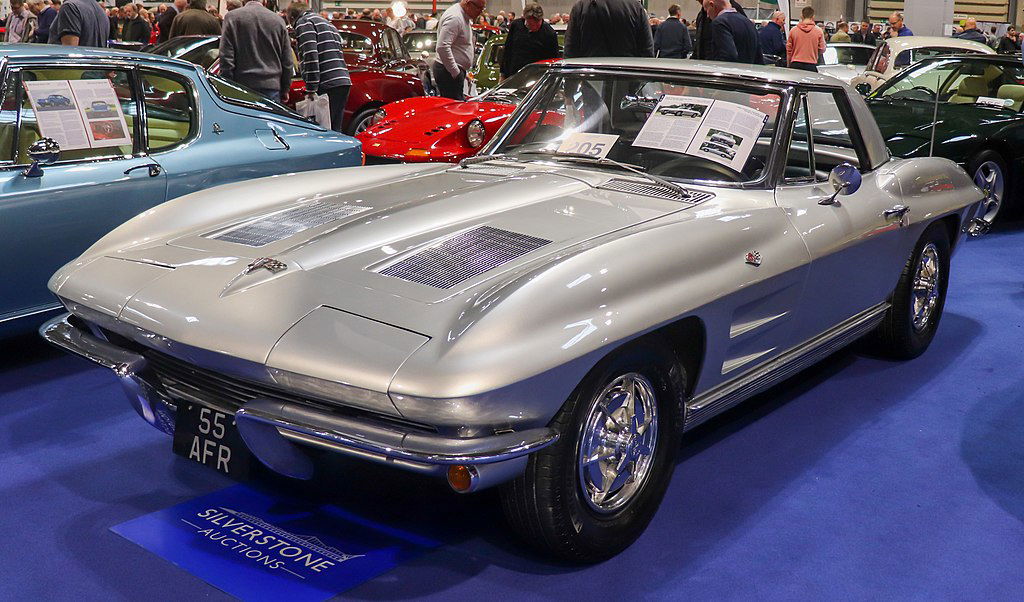
Photo credit: Vauxford via Wikimedia
As Duntov worked on an innovative chassis, designers refined the racing Sting Ray's look for the production model. By early 1960, a functional space buck was completed, and production coupe styling was mostly finalized by April. The interior, including the instrument panel, was in place by November.
Wind tunnel testing, a first for the Corvette, influenced the final shape along with practical considerations like interior space and tooling limitations. Both body styles underwent extensive evaluation as production-ready 3/8-scale models at the Caltech wind tunnel.
The vehicle's inner structure received significant attention, maintaining fiberglass outer panels but introducing nearly twice as much steel support as the 1958–62 Corvette. This extra weight was offset by a reduction in fiberglass thickness, resulting in a finished product that weighed slightly less than the old roadster.
Despite a tighter wheelbase, the passenger room remained generous, and the reinforcing steel girder enhanced the cockpit's strength and safety.
Bill Mitchell Did Not Invent The Split-Window Corvette Design
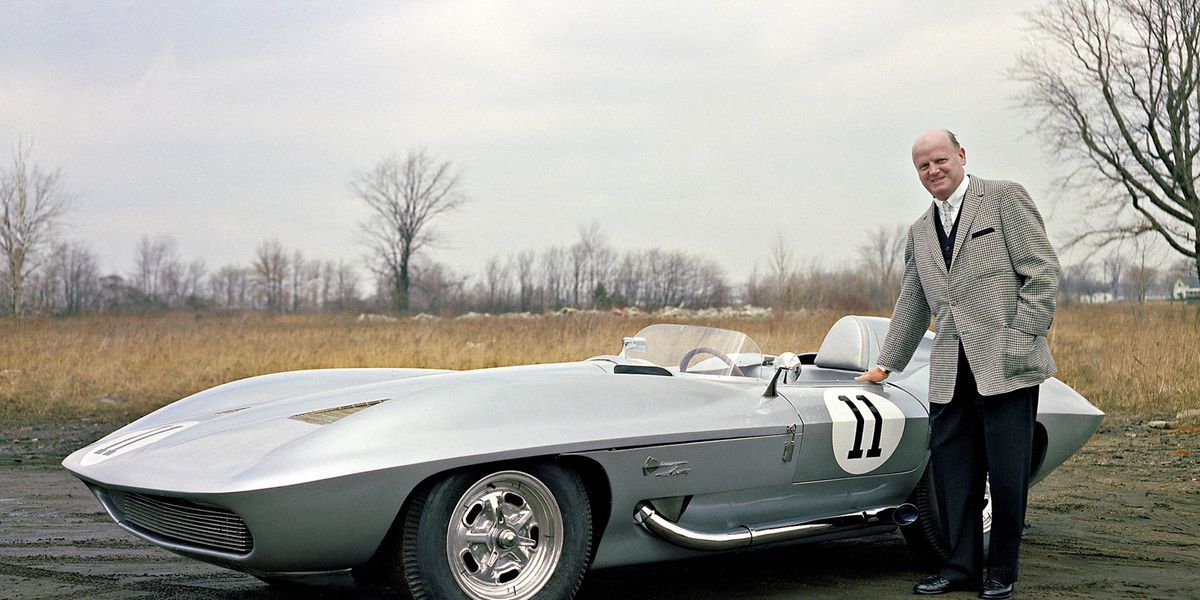
Bill Mitchell standing beside the 1959 Chevy Sting Ray Racer
The inaugural production Corvette coupe boasted a distinctive fastback body featuring a long hood and a raised windsplit running along the roof's length and descending the back on a pillar dividing the rear window into right and left halves.
Although often attributed to Mitchell, the split backlite actually predated both the C2 Corvette and Bob McLean's Q-Corvette.
Harley Earl, who used this feature on his Oldsmobile Golden Rocket show car and design studies for the C2 Corvette, drew inspiration from a Scaglione-bodied Alfa Romeo coupé showcased at the 1954 Turin Auto Show.
This design influence would later be echoed in the third-generation Buick Riviera from 1971 to 1973. The distinctive quad headlamps were newly hidden – a rarity in American cars since the 1942 DeSoto.
These lamps were housed in rotating enclosures that seamlessly blended with the sharp-edged front end when "closed." This hidden headlamp design persisted in the Corvette until the C6 model debuted in 2005.
The coupe's doors were cleverly cut into the roof to facilitate easier entry and exit for occupants in the low-slung closed car. Faux vents adorned the hood and rear pillars of the coupe, with initially planned functional ones being canceled due to cost considerations.
The C2 Sting Ray’s Interior And Exterior Design
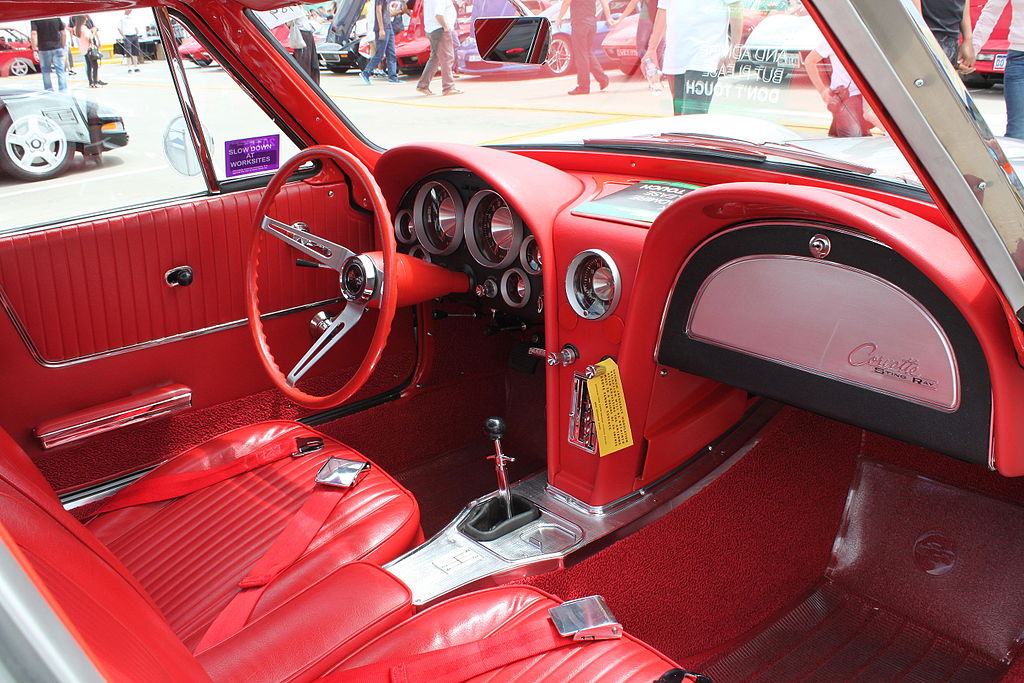
"63 Corvette Z06 interior - Photo credit: Jeremy via Wikimedia
The Sting Ray's interior showcased a re-imagined twin-cowl Corvette dash motif, a design element in use since 1958. This updated version was not only more practical but also incorporated a spacious glovebox, an improved heater, and the addition of a cowl ventilation system.
The instrument cluster featured a comprehensive set of round gauges, including a substantial speedometer and tachometer. The iconic control tower center console returned, albeit slimmer, now housing the clock and a vertically positioned radio.
Luggage space was enhanced, requiring cargo to be loaded behind the seats due to the absence of an external trunk lid. The spare tire found a new location at the rear, housed in a drop-down fiberglass compartment beneath the increased-capacity gas tank, now holding 20 US gallons instead of the previous 16.
The large round deck emblem was ingeniously hinged to serve as a fuel-filler flap, replacing the previous left-flank door. Beyond the striking exterior, the Sting Ray's success was equally attributed to its new chassis.
The car achieved enhanced maneuverability through the faster recirculating ball steering, known as "Ball-Race," and a shortened wheelbase. Despite the potential for a choppier ride with a shorter wheelbase, the altered weight distribution partially compensated for it.
The reduced weight on the front wheels contributed to easier steering, while an additional 80 pounds on the rear wheels improved traction. Stopping power saw an upgrade with standard four-wheel cast-iron 11-inch drum brakes that were now wider, providing a larger effective braking area.
Optional features included sintered-metallic linings, segmented for cooling, and Al-Fin brake drums, offering faster heat dissipation and reduced unsprung weight. Power assist was available for both brake packages.
See also: The Evolution of Mercedes-Benz: A Look Back At The First Model
The “63 Corvette Sting Ray’s Specification
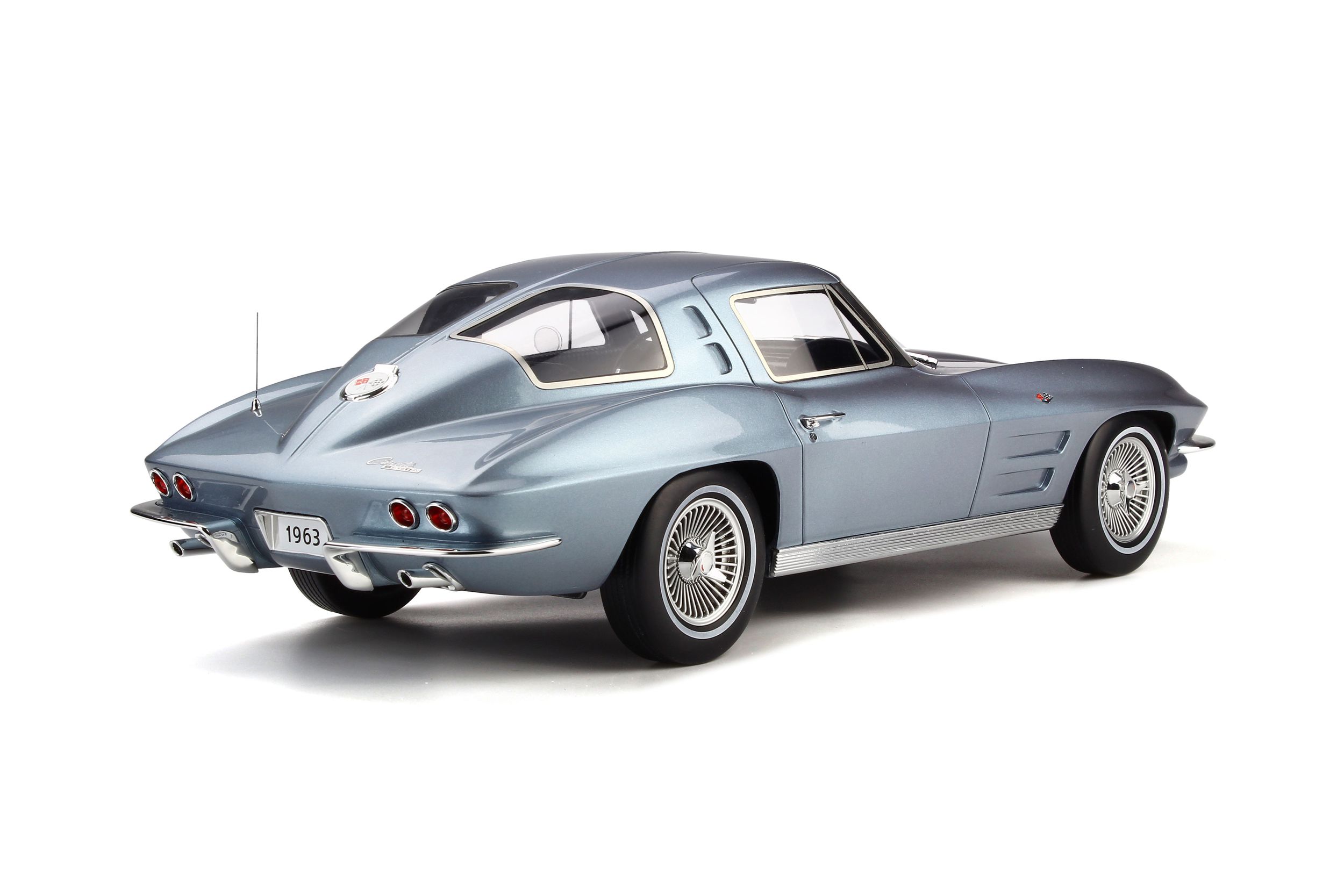
Evolutionary engineering changes further enhanced the Sting Ray's performance, featuring positive crankcase ventilation, a smaller flywheel, and an aluminum clutch housing. The transition to a more efficient alternator marked a departure from the traditional generator setup.
Duntov's independent rear suspension, originating from the CERV I concept, featured a frame-mounted differential with U-jointed half-shafts connected by a transverse leaf spring. Rubber-cushioned struts supporting the differential contributed to a smoother ride and improved tire adhesion, particularly on uneven roads.
The transverse spring was secured to the rear of the differential case, with lateral control arms extending from each side to a hub carrier. Trailing radius rods mounted behind the case managed fore/aft wheel motion and transmitted braking torque to the frame, while the half-shafts functioned as upper control arms.
Conventional twin-tube shock absorbers complemented this setup. This new rear suspension system, considerably lighter than the previous solid axle, significantly reduced unsprung weight—a crucial factor since the 1963 model retained the previous generation's outboard rear brakes.
The front suspension remained largely unchanged, featuring unequal-length upper and lower A-arms on coil springs concentric with the shocks and a standard anti-roll bar. The steering maintained the traditional recirculating ball design but with a higher 19.6:1 overall ratio (previously 21.0:1).
A new hydraulic steering damper, bolted to the frame rail at one end and connected to the relay rod at the other, acted as a shock absorber to absorb bumps before reaching the steering wheel.
In a notable advancement, hydraulically assisted steering became an optional feature for the first time on a Corvette (excluding the two most powerful engines). This system offered a faster 17.1:1 ratio, reducing lock-to-lock turns from 3.4 to just 2.9, enhancing the responsiveness of the 1963 Corvette Sting Ray.
“63 Corvette’s Powertrain
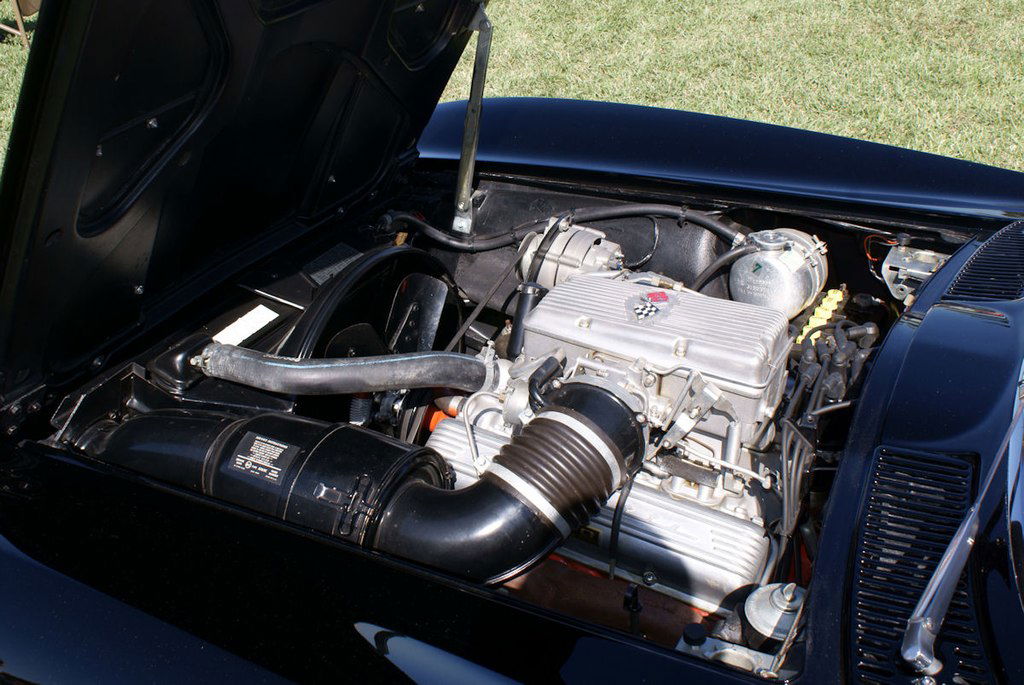
327ci V8 - Photo credit: Valder137 via Wikimedia
The drivetrains from the previous generation persisted in the C2 Corvette, featuring four 327 cu in (5,360 cc) small-block V8s, three transmissions, and six axle ratios. Carbureted engines were available in 250 hp (186 kW), 300 hp (224 kW), and 340 hp (254 kW) variants.
Both the base and optional units maintained hydraulic lifters, a mild camshaft, a forged-steel crankshaft, 10.5:1 compression, a single-point distributor, and dual exhausts.
The 300-hp engine distinguished itself with a larger four-barrel carburetor (Carter AFB), larger intake valves, and exhaust manifold. Topping the performance range was a 360 hp (268 kW) fuel-injected V8, offered for an additional $430.40 ($4,202.02, adjusted for inflation).
“63 Corvette’s Drivetrain
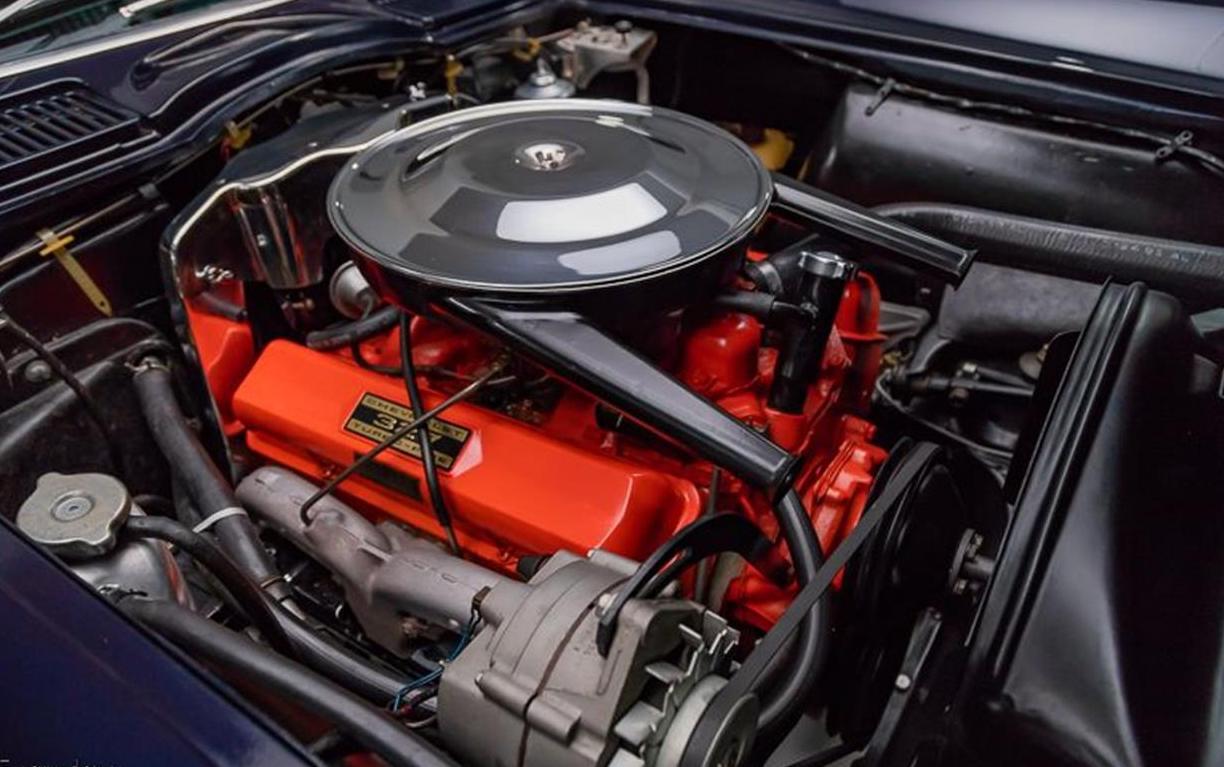
5.4-liter V8 - Photo credit: Corvsport
The standard transmission remained the familiar three-speed manual, with the preferred gearbox being the Borg-Warner four-speed, transitioning to the Muncie M20 during the 1963 model year.
The wide-ratio gears were paired with the base and 296-hp engines, while the top two powerplants featured close-ratio gearing. The standard axle ratio for the three-speed manual or two-speed Powerglide automatic was 3.36:1, and the four-speed gearbox came with a 3.70:1 final drive.
Additional gearsets of 3.08:1, 3.55:1, 4.11:1, and 4.56:1 were available, with the last being relatively rare in production.
See also: Timeless Treasures: The Top 10 Most Valuable Classic Cars 2023
Duntov Disliked The Split-Window
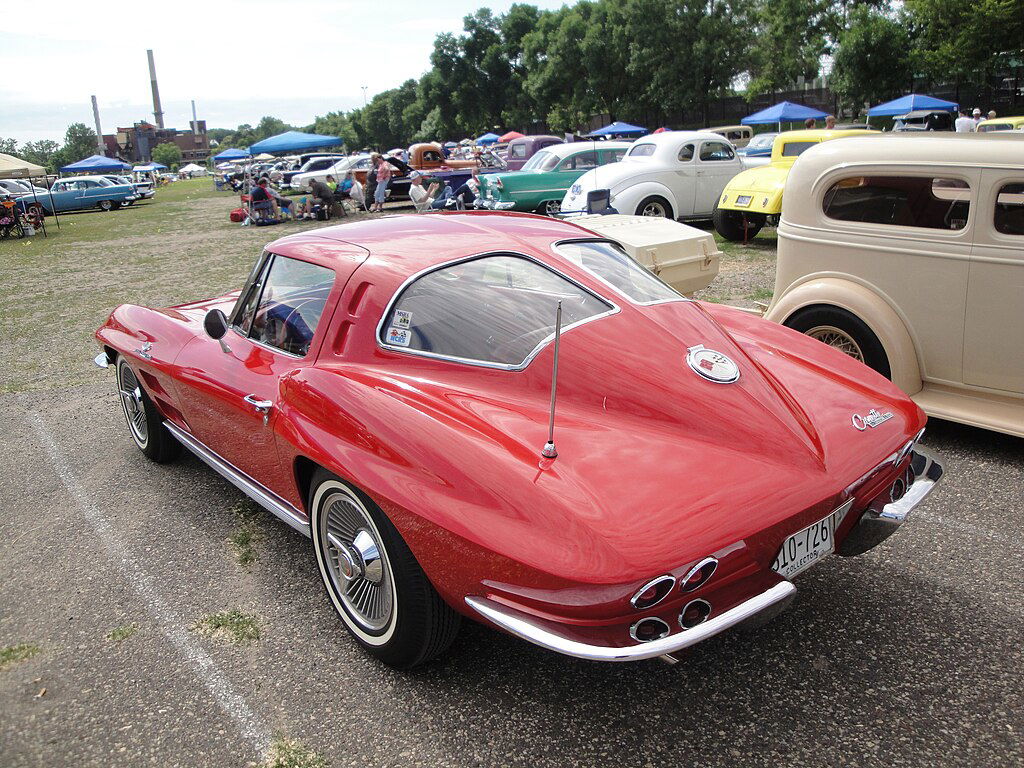
Photo credit: Greg Gjerdingen via Wikimedia
Recognizing the need for a new direction after a decade, Corvette's designers and engineers, including Ed Cole, Duntov, and Mitchell, initiated the process to craft a worthy successor for the 1963 model year.
Breaking away from Harley Earl's original design, Mitchell named the Corvette's second generation "Sting Ray" after the earlier race car.
Designed by Larry Shinoda (with significant contributions from Pete Brock), the C2 drew inspiration from various sources, including the contemporary Jaguar E-Type, the 1959 Sting Ray Racer, and a Mako shark caught by Mitchell while deep-sea fishing.
Despite initial features like the split rear window, disliked by Duntov and discontinued in 1964 due to safety concerns, the C2 marked a transformative era for the Corvette, pushing the boundaries of design and performance. The 1963 Corvette Sting Ray not only introduced a fresh design but also exhibited enhanced handling capabilities.
Despite maintaining unchanged horsepower, the Sting Ray benefited from a slightly lighter construction, resulting in improved acceleration. The 1963 model year witnessed the production of 21,513 units, marking a remarkable 50 percent increase from the record-setting 1962 version.
The production figures were almost evenly split between the convertible and the new coupe, with 10,919 and 10,594 units, respectively. Interestingly, over half of the convertibles were ordered with the optional lift-off hardtop.
The “63 Split-Window Corvette Sales Numbers

The C2 Corvette coupe faced challenges in outselling the open-top Corvette during the Sting Ray years, a trend that didn't shift until 1969 when the coupe introduced a T-top with removable roof panels.
Equipment installations for the 1963 model reflected market demands for increased comfort in sports cars. The power brake option was selected for 15 percent of production, while power steering found its way into 12 percent of the units.
Air conditioning, a luxury addition at $421.80, was chosen by only 278 buyers. Leather upholstery, priced at a modest $80.70, adorned just 1,114 cars. The cast aluminum knock-off wheels, crafted by Kelsey-Hayes for Chevy at $322.80 per set, saw limited adoption among buyers.
However, the four-speed manual gearbox proved overwhelmingly popular, with almost 18,000 Sting Rays leaving St. Louis equipped with this option – translating to over four out of every five units.
Ultimately, Corvette sales jumped 50 percent from 14,531 units in 1962 to 21,513 in 1963 – making 10,594 coupes and 10,919 roadsters sold. All were equipped with 327 cubic inch (cid) engines with a standard 250-hp variant and optional versions producing 300 hp, 340 hp, and the most potent 360 hp Rochester fuel-injected engine.
The lineup of options for the C2 included the availability of AM-FM radio (introduced in mid-1963), air conditioning, and leather upholstery. A groundbreaking addition to the Corvette was the introduction of the RPO Z06, a special performance equipment package priced at $1,818.45 ($17,753.64, adjusted for inflation).
These Z06-equipped Corvettes, also known as the "Big Tanks," featured an initially larger 36.5-US-gallon gas tank (compared to the standard 20 gallons), specifically designed for endurance races like Sebring and Daytona.
Initially, the Z06 package was exclusive to coupes due to the oversized tank that couldn’t fit the convertible.
The “63 Corvete Z06

Photo credit: Robb Report
The 1963 production saw the creation of only 199 Z06 Corvettes, primarily reserved for racing purposes. Among these, six were specifically crafted by Chevrolet for Le Mans racing.
One of these 1963 Z06 Sting Rays, built late in 1962, participated in the Daytona 250 – American Challenge Cup, a NASCAR-sanctioned event on the Daytona Oval.
To adhere to the different rules for the Grand National stock cars, the chassis underwent extensive modifications, and an experimental 427 cubic inch (7,000 cc) engine was installed. Weighing just over 2,800 lb (1,300 kg), the car was further lightened, and Mickey Thompson contributed to the preparation.
The fiberglass Z06 "Big Tank" was replaced with an even larger 50 US-gallon metal tank. Driven by Junior Johnson, the car plowed through rain during the race, and substitute driver Billy Krause finished third behind Paul Goldsmith's Pontiac Tempest and A. J. Foyt in another Corvette.
A notable addition for the 1963 model year was the optional electronic ignition – the breakerless magnetic pulse-triggered Delcotronic, making its debut after being first offered by Pontiac on some 1963 models. This innovation aimed to enhance the ignition system's efficiency and reliability in the Corvette Sting Ray.
The “63 Split-Window Corvette’s Successor
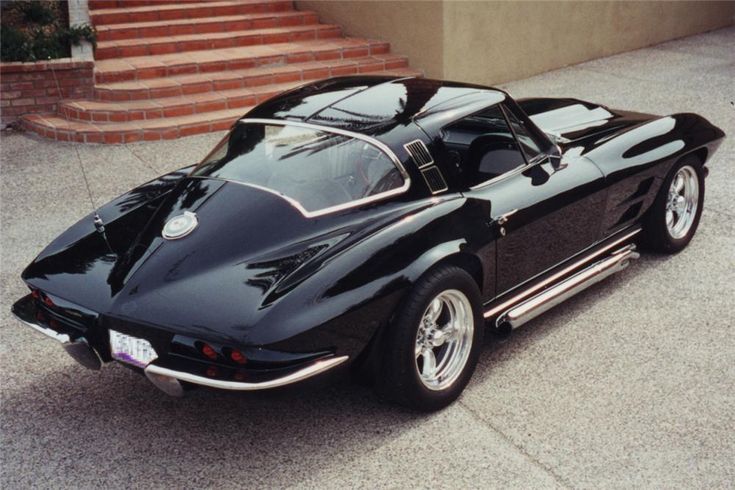
1964 Chevy Corvette - Via Pinterest
In 1964, Chevrolet introduced evolutionary changes to the Corvette. Addressing concerns over rear visibility, the coupe's distinctive two-piece split rear window was replaced by a single arched glass panel.
The coupe underwent additional modifications, including the elimination of the two simulated air intakes on the hood, though their indentations were retained.
The decorative air-exhaust vent on the coupe's rear pillar became functional, but exclusively on the left side. Rocker-panel trim lost some ribs and gained black paint in the remaining ribs, wheel covers were simplified, and the fuel filler/deck emblem now featured concentric circles around its crossed-flags insignia.
Internally, the original color-keyed steering wheel rim transitioned to a simulated walnut finish. Several suspension refinements were introduced in 1964. The front coil springs shifted from a constant rate to a progressive or variable rate, tightly wound at the top.
The leaf thickness of the rear transverse spring was adjusted for a more comfortable ride without compromising handling. Shock absorbers were reworked to align with these improvements. The 1964 Corvette featured a new standard shock with a small bag of Freon gas in its fluid reservoir to absorb heat.
The Chevy enhanced sound insulation, revised body, and transmission mounts, added more bushings to quiet the shift linkage, and introduced a new boot around the lever, resulting in a more comfortable ride for everyday transportation.
Drivetrain options remained largely unchanged, but the high-performance models received noteworthy upgrades. The solid-lifter unit, driven by a high-lift, long-duration camshaft, produced 365 horsepower (272 kW) and featured a big four-barrel Holley carburetor instead of the base engine's Carter unit.
The fuel-injected engine saw a 15 horsepower (11 kilowatts) increase, totaling 375 hp (280 kW), but at an additional cost of $538.00. Transmission options ostensibly stayed the same for 1964, but the two Borg-Warner T-10 four-speeds were replaced by a pair of gearboxes produced at GM's Muncie, Indiana, transmission facility.
Originally a Chevy design, this gearbox had an aluminum case like the Borg-Warner version but came with stronger synchronizers and wider ratios for improved durability and drivability.
The 1964 Corvette Sting Ray received widespread acclaim from enthusiasts and the media. Despite some observations about the convertible's tendency to rattle and shake on rough roads, sales reached 22,229 units, setting another record for Corvette.
The Coupe’s sales volume dipped slightly to 8,304 units, but convertible sales more than compensated for the dip, rising to 13,925. The Sting Ray earned widespread acclaim in the automotive press, receiving praise for its handling, road adhesion, and raw power.
Car Life magazine honored the 1963 Sting Ray with its Award for Engineering Excellence, highlighting the exceptional performance of Chevy's small-block V8.
The new independent rear suspension was lauded for reducing wheel spin compared to live-axle cars, resulting in improved traction and handling. Motor Trend conducted tests on a 1963 four-speed fuel-injected version with a 3.70:1 axle, recording a 0–60 mph time of 5.8 seconds and a quarter-mile time of 14.5 seconds at 102 mph.
The magazine also reported fuel efficiency of over 18 miles per gallon at legal highway speeds and 14.1 mpg overall. In 1964, Motor Trend timed a fuel-injected four-speed coupe with a 4.11:1 rear axle, aluminum knock-off wheels, sintered-metallic brakes, and Positraction. The quarter-mile was completed in 14.2 seconds at 100 mph, and the 0 to 60 mph time was 5.6 seconds.
Road & Track tested a 1964 coupe equipped with the 296-hp Powerglide automatic, achieving a 0–60 mph time of 8.0 seconds and a quarter-mile time of 15.2 seconds at 85 mph, with an average fuel consumption of 14.8 mpg.
As recently as 2004, Sports Car International ranked the Sting Ray as the fifth-best sports car of the 1960s.
How Much Is The “63 Split-Window Corvette?
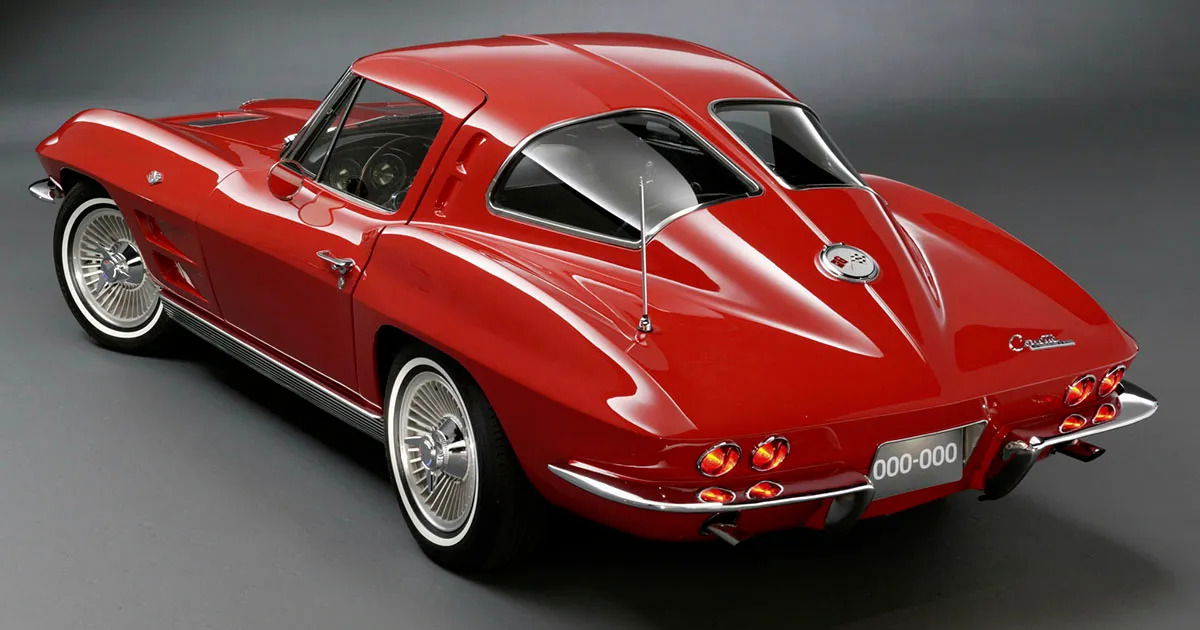
Speaking specifically about the "63 Split-Window Corvette coupes and convertibles, also called Sting Rays, they currently have a median sale value of $79,200, according to ConceptCarz's valuation tool.
Using the data gleaned from 1,179 auction sales of the 1963 Chevrolet Corvette, the cheapest "63 Split-Window Corvette has been sold is $9,388. A "63 Split-Window Corvette in perfect condition fetched $715,000 in 2022 to become the most expensive original split-window Corvette ever sold.
Note that the current market valuation of a 1963 Corvette varies depending on factors such as condition, provenance, originality, mileage, and any modifications or restoration work done.
In general, a well-maintained 1963 Corvette can range in value from around $50,000 (the lowest sale value in 2023 was $47,300) to over $150,000 (the highest sale value in 2023 was $163,700).
That’s some serious appreciation after 60 years for a car that originally hit the market with a $4,037 base price (for the convertible) and $4,257 for the coupe.